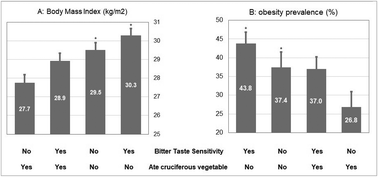Bitter taste sensitivity, cruciferous vegetable intake, obesity, and diabetes in American adults: a cross-sectional study of NHANES 2013–2014†
Abstract
Objective: To examine the associations between bitter taste sensitivity, cruciferous vegetable consumption, and likelihood of obesity and diabetes among American adults. Research design and method: Cross-section observation of 2129 adults aged 40–80 years of the National Health and Nutrition Examination Survey (NHANES) 2013–2014. Bitter taste sensitivity was estimated by the generalized labeled magnitude scale (gLMS) rating for bitterness (non-tasters: the lowest 25%, the others were tasters). Consumption of cruciferous vegetables was recorded by the 2 day 24 hours dietary records. Obesity was defined as body mass index (BMI) ≥30 kg m−2. Diabetes was defined as self-reported physician-diagnosed diabetes, or who reported taking diabetes medication or individuals with a fasting plasma glucose (FPG) ≥ 126 mg dL−1 or Hemoglobin A1c ≥ 6.5%. Results: The proportion of participants who ate cruciferous vegetables over the two days was 29.5% among bitter tasters, significantly lower than that (35.7%) among non-tasters (P = 0.04) after adjustment of age, gender, race/ethnicity, dietary energy intake, physical activity, education, smoking and income levels. Among participants who ate cruciferous vegetables, bitter tasters on average consumed 15.5 g (±7.0) grams less cruciferous vegetables per day compared to non-tasters. The multi-variates adjusted odds ratio of obesity was 1.29 (95% confident interval (CI): 0.76–2.17), 1.40 (95% CI: 0.90–2.18) and 1.68 (95% CI: 1.05–2.67) among bitter tasters who ate cruciferous vegetables, among non-tasters who did not ate cruciferous vegetables, and among bitter tasters who did not eat cruciferous vegetables, respectively, as compared with non-tasters who ate cruciferous vegetables. The prevalence of diabetes was 17.3% and 13.0% among bitter tasters and non-tasters, respectively, with a multi-adjusted odds ratio of 1.32 (95% CI: 1.02–1.69, P = 0.033) for diabetes comparing bitter tasters with non-tasters, which was attenuated to 1.26 (95% CI: 0.95–1.67, P = 0.108) by further adjustment of cruciferous vegetables consumption and obesity, with a mediation effect of 17.8% (95% CI: 2.9%–60.9%; P = 0.069). Conclusion: Bitter taste sensitivity was associated with less consumption of cruciferous vegetables and a high likelihood of obesity, which may mediate its association with diabetes.



 Please wait while we load your content...
Please wait while we load your content...